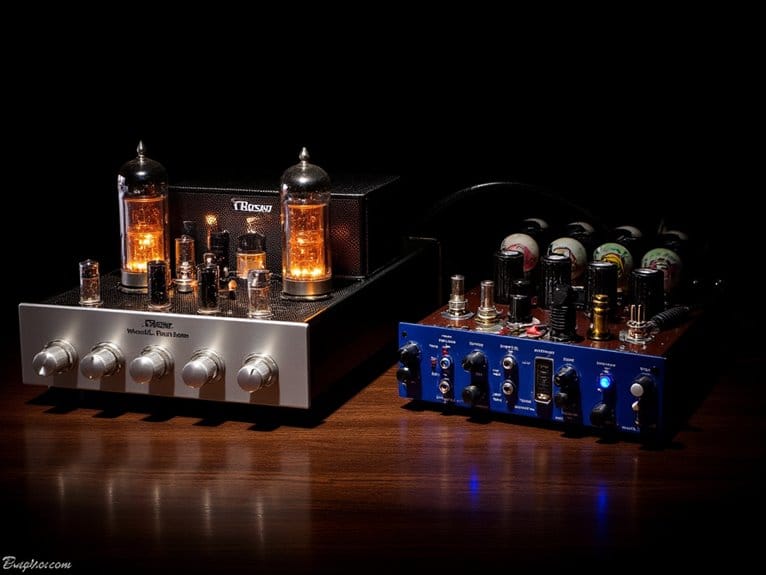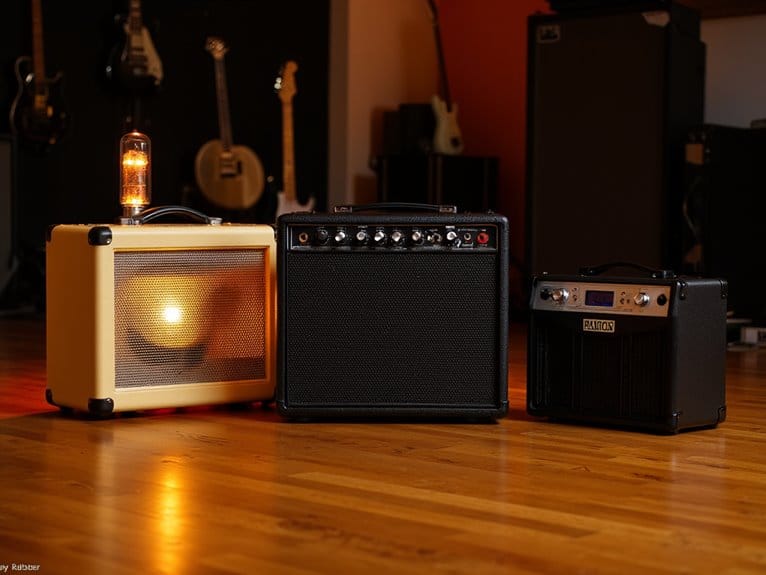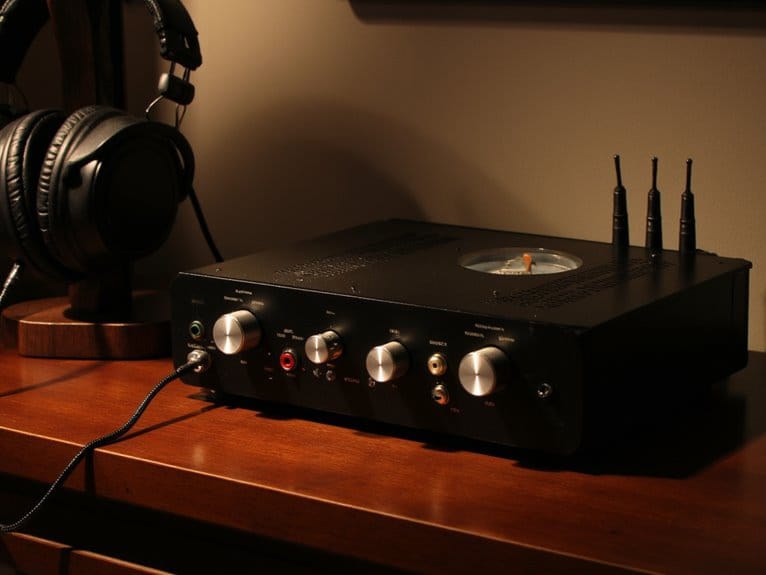Short Scale Vs Long Scale Bass Guitars Explained
Short-scale basses (30-32 inches) offer warmer, mellower tones with reduced string tension that’s easier on your fingers, while long-scale basses (34 inches) deliver brighter, more articulate sounds with higher tension requiring greater finger strength. You’ll find short scales excel in jazz and blues with their vintage character, whereas long scales provide the punchy clarity needed for rock and metal. Your hand size, musical style, and comfort preferences should guide this choice, though there’s much more to evaluate about setup requirements and tonal nuances.
We are supported by our audience. When you purchase through links on our site, we may earn an affiliate commission, at no extra cost for you. Learn more.
Notable Insights
- Scale length affects playability: short scale (30-32″) offers easier fretting for smaller hands, while long scale (34″) requires greater reach and finger strength.
- Tonal characteristics differ significantly: short scale produces warm, mellow sounds ideal for jazz and blues, while long scale delivers bright, articulate tones perfect for rock.
- String tension varies between scales: short scale has lower tension reducing finger fatigue, while long scale creates higher tension requiring more physical effort.
- Musical applications suit different genres: short scale excels in vintage styles and fingerstyle playing, while long scale works best for slap bass and metal.
- Market options span all budgets: both scales available from $150 budget models to $1,500+ boutique instruments across major and specialty manufacturers.
Understanding Scale Length Measurements and Standards
While the term “scale length” might sound intimidating to newcomers, I’ve found that understanding this fundamental measurement is actually quite straightforward once you know the simple formula behind it.
Understanding scale length becomes surprisingly simple once you grasp the basic measurement principle behind this essential guitar specification.
You’ll measure scale length by doubling the distance from the nut to the center of the 12th fret, which locates where your string breaks at the bridge and defines the vibrating length that affects pitch and tension.
This method provides measurement accuracy by disregarding minor adjustments from bridge saddles that create scale length variations among individual strings.
The industry recognizes four main categories: short scale (30-32 inches), medium scale (32-34 inches), long scale (typically 34 inches), and extra-long scale (36+ inches), though these represent guidelines rather than absolute standards. The 34″ standard was established by Leo Fender in 1951 with the introduction of the Precision Bass, creating a foundation that balanced playability and tonal quality for professional players. It’s important to note that the actual speaking length between the nut and bridge saddle will be slightly longer than the calculated scale length due to intonation compensation adjustments.
Scale length directly influences string tension throughout the instrument, which affects both the physical effort required for fretting and the overall tone quality you’ll achieve.
Tonal Differences Between Short and Long Scale Basses
When you’re comparing the sonic characteristics of short and long scale basses, you’ll immediately notice how the harmonic structure creates distinctly different tonal personalities. Short scales produce tightly packed overtones that generate warmer, rounder sounds, while long scales spread harmonics wider for brighter, more articulate tones.
This fundamental difference in harmonic spacing directly impacts how your bass will sit in a mix, as the concentrated harmonics of short scales create that vintage, mellow foundation perfect for classic rock or jazz. The pickup configuration also plays a crucial role in shaping these tonal characteristics, with single-coil pickups emphasizing the natural brightness of long scales while humbuckers can add warmth to compensate for the inherent brightness.
On the other hand, the spread-out harmonics of long scales cut through dense modern arrangements with superior clarity. The 34-inch scale length established by Leo Fender became the industry standard that most modern manufacturers continue to follow today.
I’ve found that understanding these harmonic differences helps you choose the right tool for your musical context, whether you need the warm presence of a short scale or the punchy articulation that long scales deliver in complex mixes.
Harmonic Structure Impact
As someone who’s spent countless hours comparing bass tones in recording studios, I can tell you that the harmonic structure differences between short and long scale basses create some of the most noticeable tonal variations you’ll encounter in the bass world.
The harmonic complexity you’ll experience varies dramatically between these two designs, primarily because of how string length affects resonance patterns.
Here’s what you need to know about harmonic structure impact:
- Fundamental frequency dominance – Short scale basses emphasize the root note’s fundamental frequency more strongly than their long-scale counterparts.
- Overtone clarity – Long scale instruments generate more defined higher-order harmonics, creating brighter, more articulate tones.
- Harmonic node activation – Longer strings create more harmonic nodes, increasing spectral complexity and clarity across the frequency spectrum.
These differences directly influence your bass’s tonal character in any recording or live situation.
Mix Presence Characteristics
The harmonic complexity we’ve just explored translates directly into how these instruments sit within your mix, and I’ll be honest—this is where the rubber really meets the road regarding practical application.
Short scale warmth manifests as a fuller, rounder presence that occupies the low-mid frequencies beautifully, though it can sacrifice upper-range articulation. You’ll notice this creates a vintage, thick body that blends smoothly but may require EQ adjustments for definition.
Conversely, long scale clarity emerges through tighter string tension, delivering pronounced midrange punch and enhanced note separation that cuts through dense arrangements. The increased sustain maintains consistent presence over time, while the brighter character guarantees your bass lines remain articulate, particularly essential in funk or metal contexts where every note must be distinctly heard.
Playability and Ergonomic Considerations
When you’re deciding between short and long scale basses, your hand size and comfort level become essential factors that’ll directly impact your playing experience, technique development, and overall enjoyment of the instrument.
The reduced fret spacing on short-scale basses, typically around 30 inches compared to the standard 34-inch long scale, means you won’t need to stretch your fingers as far between frets. This can be a game-changer if you have smaller hands or you’re just starting out.
Additionally, the lower string tension on short-scale instruments makes fretting notes considerably easier. However, this reduced tension can sometimes create a trade-off with the tighter, more controlled feel that many players prefer from long-scale basses.
The standard 34-inch scale length strikes an optimal balance between string tension and low-end punch, making it a popular choice for many players across different styles. Many jazz bassists particularly appreciate this scale length because it provides the proper string tension needed for the smooth, rich tones that define the genre, as evidenced by instruments like the Fender Jazz Bass which has become synonymous with jazz music.
Longer scales tend to produce brighter characteristics and are favored by slap bassists, while shorter scales provide warmer tones for fingerstyle players.
Hand Size and Stretch
Finding a bass guitar that fits your hands properly isn’t just about comfort—it’s about preventing injury and maximizing your playing potential over years of practice and performance.
Your hand span directly determines which scale length will work best for you, and I’ve learned that ignoring this measurement leads to frustration and potential injury down the road.
Here’s what you need to take into account when matching your hands to a bass:
- Measure your hand span – Adults with spans under 170mm typically need short-scale basses.
- Assess your finger flexibility – Limited reach benefits from closer fret spacing on short scales.
- Reflect on long-term comfort – Ergonomic mismatches cause fatigue and compromise your technique over extended playing sessions.
Choosing the wrong scale length forces compensatory movements that’ll limit your endurance and development.
When selecting your first instrument, consider that many beginner bass guitars feature lightweight designs specifically tailored for new players with varying hand sizes and comfort needs.
Many quality instruments feature a comfortable neck profile designed to reduce hand fatigue during practice sessions, making them ideal for players still developing their finger strength and dexterity.
The neck shape you choose can significantly impact your comfort level, with C-shaped profiles offering versatility for most hand sizes while D-shaped necks provide a fuller grip better suited for larger hands.
String Tension Effects
Although hand size determines whether you can physically reach the frets, string tension affects how much effort you’ll need to fret those notes once you get there.
I’ve found this difference between short and long scale basses dramatically impacts your playing experience. Long scale basses generate approximately 6% higher string tension than short scales with identical strings, creating tighter resistance that requires more finger strength but delivers brighter, snappier tones.
Short scale basses offer lower tension that reduces finger fatigue, allows easier bending, and produces warmer tonal nuances through their looser string feel. The comfortable neck design becomes particularly important during extended playing sessions, as proper ergonomics can significantly improve your overall playing experience.
You can adjust string gauge to manage these effects—thicker strings on short scales compensate for lower tension, while thinner strings on long scales ease playability without drastically shifting your instrument’s fundamental character. These tension differences become even more noticeable when you upgrade from stock components to high-output pickups that enhance your bass’s tonal dynamics.
For those just starting out, beginner bass guitars in the $130-$200 range often come in both scale lengths, allowing new players to experience these tension differences while developing their playing technique.
String Selection and Setup Requirements
Three fundamental factors determine your string selection and setup success: scale length, gauge compatibility, and tension balance.
I’ve learned through years of setup work that getting these right makes the difference between a bass that fights you and one that feels like an extension of your hands.
Your string compatibility requirements vary dramatically between scales, demanding specific approaches for peak performance:
Scale length dictates everything about your string choice—ignore this relationship and watch your bass fight back with poor intonation and frustrating feel.
- Short scale basses need heavier gauge strings to compensate for naturally lower tension and prevent that frustrating “floppy” feel that ruins your attack.
- Long scale instruments work beautifully with lighter gauges while maintaining proper tension for defined tone and reliable intonation.
- Setup adjustments for tension adjustment include saddle positioning, neck relief, and action height modifications based on your chosen scale’s unique characteristics.
Getting these fundamentals right transforms your playing experience completely. The material influence of your string choice—whether nickel-plated steel for brightness or pure nickel for warmth—significantly affects how your particular scale length responds to different playing techniques. Quality instrument cables also play a crucial role in maintaining signal clarity between your bass and amplifier, especially when using different string gauges that can affect your overall tone. Short scale models like the Ibanez GSRM20 Mikro demonstrate how reduced string tension can create warm, deep tones while maintaining authentic bass frequencies.
Musical Genres and Performance Applications
When I started playing professionally decades ago, I quickly discovered that your bass scale choice can make or break your sound in specific musical contexts. After countless gigs across every genre imaginable, I’ve witnessed firsthand how the wrong scale length creates an uphill battle against your music’s natural character.
Short-scale basses excel in blues, jazz, and R&B, where their warm, thumpy tone blends seamlessly with vintage-inspired arrangements. Their reduced string tension accommodates fingerstyle techniques beautifully. The C-shaped neck profile found on many short-scale instruments enhances comfort during extended playing sessions, making them particularly appealing for intimate performances.
Long-scale instruments dominate rock and metal performance contexts, delivering the bright articulation and sustain needed to cut through high-volume mixes. These genre influences extend beyond recording into live applications, where short-scale basses provide intimate acoustic warmth, and long-scale models project clarity in aggressive concert environments requiring maximum sonic presence. While bass guitars typically use four strings, many heavy music genres benefit from extended-range techniques that add sonic depth to power chord progressions. Whether you’re performing at home sessions or small venues, having the right bass practice amp matched to your scale choice ensures your instrument’s natural characteristics shine through during rehearsals and intimate performances.
Popular Models and Market Availability
Since my early days browsing music stores with limited budgets, I’ve watched the short-scale bass market transform from a niche corner dominated by vintage Fender Mustangs and Gibson EB-3s into today’s diverse landscape where you’ll find everything from $150 Ibanez Talman models to $3,000 boutique Serek creations sitting side by side on shop walls.
The current market breaks down into three distinct price tiers:
- Budget options ($150-$300): Ibanez TMB30, Squier Bronco, and Gretsch G2220 Junior Jet II
- Mid-range selections ($400-$700): Fender Mustang reissues and upgraded Gretsch models
- Premium/boutique instruments ($1,500+): Serek Midwestern II, Alembic, and vintage Gibson EB-3s
Popular brands like Fender and Gibson maintain strong collector interest, while boutique manufacturers offer limited production runs that command premium prices.
This makes short-scale basses accessible across every budget range. Many of these instruments feature quality materials like maple necks and solid wood bodies that deliver professional-grade performance regardless of price point.
Choosing the Right Scale Length for Your Needs
Which scale length will transform your playing experience from frustrating struggle to effortless expression? I’ve found that matching scale length to your physical attributes and musical goals determines whether you’ll develop smoothly or hit frustrating plateaus.
| Factor | Short Scale (30″) | Long Scale (34″) |
|---|---|---|
| Hand Size | Perfect for smaller hands | Requires larger reach |
| Tone Character | Warm, mellow bottom end | Bright, punchy clarity |
| Playing Comfort | Reduced finger fatigue | Higher string tension |
Your finger comfort directly impacts practice duration and technique development, while scale versatility affects the musical styles you can effectively tackle. Consider your hand span first—if stretching feels uncomfortable on long scales, you’ll naturally gravitate toward short scales’ easier fret access and lower tension, which encourages longer practice sessions. The right 3-band EQ settings can further optimize your bass tone regardless of which scale length you choose. Regardless of scale choice, a quality bass preamp can enhance your tonal flexibility for both live performances and studio recording applications.
Frequently Asked Questions
Do Short-Scale Basses Have Worse Intonation Problems Than Long-Scale Basses?
Yes, you’ll find short-scale basses have more intonation problems than long-scale basses. The shorter scale length creates lower string tension, reducing intonation stability and making strings more susceptible to going out of tune during playing.
Are Short-Scale Basses Louder or Quieter Than Long-Scale Basses Acoustically?
You’ll find acoustic volume between short and long-scale basses is quite similar. Tonal differences are more noticeable – short-scales sound warmer while long-scales offer brighter projection, but actual loudness depends primarily on body construction.
Will Switching Scale Lengths Affect My Playing Technique and Muscle Memory?
Yes, switching scale lengths will definitely affect your playing technique and muscle memory. You’ll need to readjust your finger positioning and playing comfort as fret spacing and string tension change between different scale lengths.
On a final note
You’ll find that choosing between short and long scale basses ultimately depends on your physical comfort, musical style, and tonal preferences. If you’re playing funk or need quick fretwork, short scale‘s easier reach might suit you better. For rock, metal, or situations requiring maximum clarity and punch, long scale delivers superior performance. Don’t overthink it—try both options when possible, and trust your hands to guide the decision.






